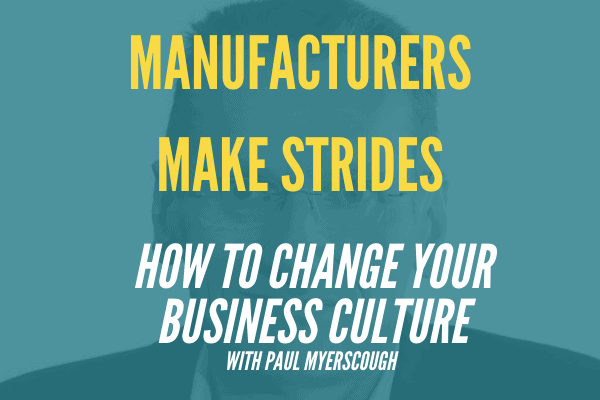Many components of business culture have changed over the past few decades. It is a lot more informal, and there is a substantial focus on including various departments in business developments. So, where there used to be a very high level of hierarchy in business, leaders are now starting to leverage all levels of operation to increase productivity and innovation.
One of the biggest facets of changing business culture and improving productivity, is to approach people at a “human” or emotional level while also incorporating the appropriate amount of factual communication.
We interviewed experienced MD, advisor, and coach, Paul Myerscough, on what he thinks the key principles are for good coaching and leadership to improve business culture.
Watch our video to find out how you can utilise leadership, coaching, and data to change your business culture and increase productivity throughout your manufacturing processes.
What are the key things that helped you get where you are today?
The key thing for me was seeing how, very often, people can be underutilised at work. The culture isn’t there for people to participate in improving the place. So, what stayed with me was how to engage and motivate people to get the best out of them, and get businesses onto growth and world-class.
There’s still a lot of companies that are either laissez-faire, or they’re so short term that they don’t really invest in developing the people. They don’t invest in engaging the people in the processes and implementation of things. There’s an awful lot that are still pretty traditional, and pretty top down. It’s easy for leaders to get into the mode of telling people what to do and believing that these guys, will do alright, but we’ve got to constantly watch them and make sure we’re clear about what there is to do. It’s that sort of attitude that perpetuates a culture where people are not really that interested in people, and you don’t get the most out of them.
What are the key principles of good coaching and leadership in business culture?
Well, one is being human and engaging people at an emotional level. We’re all emotional beings. We’ve got to connect emotionally as well as factually.
Another key thing is asking open questions. So if you’re leading with a coaching style, it’s about asking open questions and avoid rushing to suggest what to do all the time. This is so easy to do because you might know the answer. However, if people are to develop and gain confidence and ownership, then it’s better to get them to come up with the answers themselves, wherever possible.
How does data play a role in helping people to motivate teams and get better results?
Well, this is the opportunity to bring the ying together with the yang. So typically, you might see people in an oversimplified way. For example, your engineering data orientated geeks on the one hand and you’re sort of touchy-feely talkers on the other hand. But, we all have both of those aspects in us, it’s just a question of to what extent. What we can do is use data to bring the two together to improve the business.
What I would do, as an example, is to choose a problem to solve or performance to improve and set up some data collection and measures to get people involved wherever possible. Get them involved in collecting the data on whatever performance you’re talking about and then create a run chart, a line graph of what’s happening over time, so you can see trends and see variability.
The great Dr W. Edwards Deming, father of the quality revolution, was famous for understanding how to use data to improve processes. With a simple run chart, you can understand the difference between a common cause and a special cause.
How would you successfully implement a change in business culture?
The key to leading transformation is starting with “the why” that Simon Sinek talks about. What’s the purpose? What’s the driver that can engage people?
Also, listen to people. Talk to them and understand what the stones in the shoes are. Then, when you develop a plan to deliver that new purpose and goal, make sure they’re included. Make the changes part of the way you do business week to week, month to month. If it’s part of your regular meetings, it will always be on the agenda and will just become the natural way of doing things.
Do you have any favourite book recommendations?
If you’re talking about data and improvement, Out of the Crisis by Dr W Edwards Demming is a classic example of the books that are about him and his approaches. If you’re looking for something more about leading transformation, then John Cotter is good for strategy development and deployment.
There are some great coaching books out there as well that I would really recommend. There’s also, The Coaching Manual by Julie Star and The Business Coaching Handbook by Curly Martin.
Get in touch with Paul
You can contact Paul or find out more about him at linkedin.com/in/paulmyerscough




